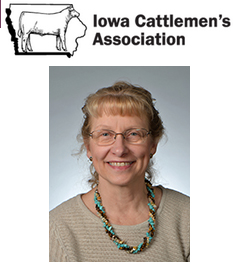Director Column
IBC director's monthly column featured in Cattleman Magazine. Archives |
|||
|---|---|---|---|
 Denise Schwab, interim IBC director
|
May 2024Happy May Beef Month! When writing this it looks like we might get some much-needed moisture, but even if we get some good April rains, our pastures will still likely be behind normal this spring, so I thought I’d share some of the forage projects we’ve done at the Iowa Beef Center. One that I’ve been directly involved with is a winter annual/summer annual forage rotation at the Northeast Iowa Research Farm at Nashua. For three years we planted four winter annual varieties with two nitrogen rates, harvested in the spring and followed with four summer annual varieties also with two nitrogen rates. The summer annual varieties were harvested once or twice in the summer, then terminated and followed by the winter annuals again. I think it would be better as a one year rotation to break up the traditional corn-soybean rotation, especially in areas where corn rootworm has become a major problem. Our summer annual grasses (sorghum, sudangrass, millets) are resistant to corn root worms so we can break up the extended diapause. Summer annuals also require less water than other forages. During this trial we had a good deal of droughty conditions, but still produced between 7 and 11 tons of dry matter forage in the winter annual/summer annual rotation. Due to the very dry conditions during germination in 2023 we only harvested the summer annuals once. This trial was mechanically harvested so if grazing would need to account for grazing losses in the total yield available. Some rough cowboy math would say 7 tons of dry matter per acre adjusted for a 50% grazing utilization would provide about 200 cow grazing days per acre during the heat of the summer. Remember that sorghum and sudangrass does have a risk of both prussic acid poisoning (mostly lush new growth on young shoots) and nitrate poisoning (dry conditions followed by rain just ahead of harvest), so use caution when grazing. If you want to learn more about this project see the Animal Industry Report. Another project using summer annuals was completed by Garland Dahlke at the Beef Teaching Farm and is now being replicated at other farms. This trail allowed warm season annuals to grow into the winter, when it was mowed and swathed for winter grazing. In the first year they grazed 80 spring-calving cows on 36 acres from late December until mid-February. The millet and sorghum was mowed and raked into swaths in early December, just prior to snowfall. Temperatures and snowfall were typical of Iowa winters with 3-12” of snow during most of the grazing period. Cows were given a 3-day supply of forage with the tumblewheel fence running perpendicular to the windrows. Forage quality was tested throughout the grazing period, and quantity was measured before and after grazing to determine utilization. Quality decreased during the winter grazing period as expected but still met the requirements for gestating, mature cows. About 70% of the forage in the windrow was utilized by the cattle, leaving very little behind to manage the next spring. Details on this study can be found here. This trial is being replicated in more locations so watch for updates in the future. Another trial that is in progress is seeding Sudangrass into poor stands of permanent pasture. Beth Reynolds is leading the project on three cooperating farms across the state. Last year was the first of a 3-year trial, and the drought conditions drastically limited germination results. Some growth was realized in July and August, primarily in areas with the least competition. We think this has great potential for calving pastures or sacrifice paddocks, and hopefully we have enough rain this year to show good results. With the addition of Shelby Gruss to our team, watch for even more forage research in upcoming years. We all know our ability to produce beef is dependent on our ability to raise forages! The IBC at Iowa State University serves as the university’s extension program to cattle producers. Our center comprises a team of faculty and staff from the College of Agriculture and Life Sciences, the College of Veterinary Medicine and Iowa State University Extension and Outreach. We work together to develop and deliver the latest in research-based information to improve the profitability and vitality of Iowa’s beef industry. If you’d like to be notified of updates on progress of research projects or programs that might be coming to your area, please subscribe to our “Growing Beef" newsletter by following the link on our website, www.iowabeefcenter.org. If you have a question, use our “Ask our Experts” link. Also, feel free to call us at 515-294-BEEF or email us at beefcenter@iastate.edu. You can follow @iowabeefcenter on Facebook, Twitter, YouTube and Instagram. |
||
Archives
|
